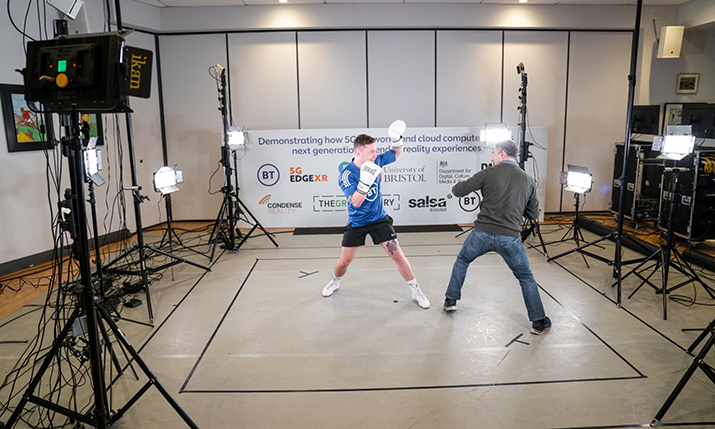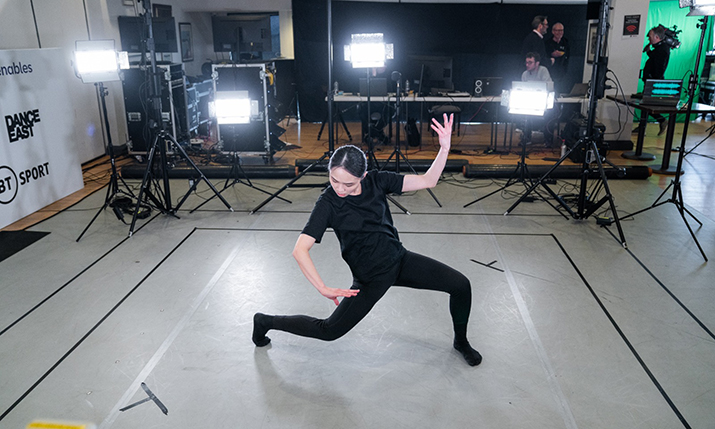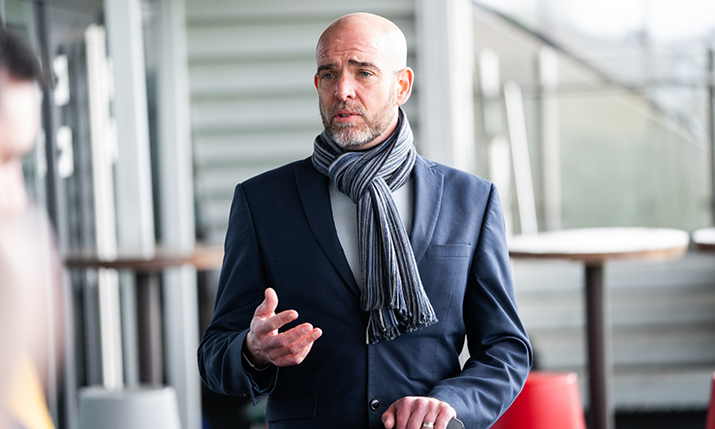EE and BT Sport reveal new sports experiences fuelled by 5G and extended reality

At the EE and BT Sport demonstration, a boxer takes an attendee through his paces to demonstrate a first-of-its-kind immersive sports-viewing experience, bringing live fights from the ring into the front room
EE and BT Sport have unveiled new ways to watch and experience sports and the performing arts using 5G and extended reality (XR) technology, developed through an EE and BT Sport-led project, 5G Edge-XR.
The project demonstrates how the potential of EE’s 5G network, paired with cloud graphics processing units, can enable consumers to view events in a range of new, highly immersive ways.
Earlier this week BT Sport and EE showcased the new experiences on a standalone 5G network, including real-time mixed reality overlays for rugby coverage and augmented reality fan experiences for MotoGP.
“We see the crossover between being able to provide really immersive experiences, and also we want them to be realistic, but we want to stay with the editorial and provide great output”
5G Edge-XR is supported by UK government agency, the Department of Digital, Culture, Media & Sport (DCMS), The Grid Factory, Condense Reality, DanceEast, Salsa Sound and The University of Bristol. Other high-end XR services being explored by the project address the needs of industries as diverse as construction, health and retail.
Speaking to SVG Europe, Matt Stagg, BT Sport’s director of mobile experience, says the aim of this trial and where it is going is the future of sports broadcasting. “This is where we move towards the metaverse,” he states. “On what the metaverse could be, for me it’s an evolution of social viewing.
“Number one, if you’re a sports fan you want to be at the stadium, but it’s not possible for everyone for many reasons – it’s difficult sometimes to get tickets, you might not have accessibility, you might not be able to afford it as it’s very expensive – but I think we’re bridging that gap between being at the stadium [or not]. The next best thing [to being at the stadium] is watching on as big a screen as possible with friends, as it’s a social experience. What we wanted to look at [in this project] is how we could use this technology along with everything we’ve got in the consortium using 5G and edge computing to be able to bridge that gap between the stadium and the TV, and that’s where we’re going with a lot of these experiences.
“That’s where we see sport looking at a metaverse,” he continues. “It’s just how do you get people together when they’re somewhere else and want to watch sport, and how do you make that as close to being together at a stadium as you can?”
The demonstration was provided on a standalone 5G network especially created to demonstrate the optimum benefits of a 5G core-based network, as opposed to running a 5G technology overlay on top of a 4G network, which is what EE is currently providing to consumers to get some of the benefits of 5G out to consumers. A 5G core-based standalone network will provide the full benefits of 5G, including network slicing and edge computing, and being able to put prioritisation on certain things going over the network.
Stagg explains: “Standalone is where you have a 5G core. At the moment, the original 5G [offering from EE] was built on a 4G core, just to get it out as quickly as possible.”
EE is in the process of deploying a new 5G core network upgrade which will launch by 2023.
“If you’re trying to do experiences where you can walk around, you have to have the sound follow you to those locations. You don’t want to be on one side [of the holographic ring] hearing the sound of the boxer on the other side, and as you move round it all stays the same, because it won’t fully immerse you”
EE and BT Sport are looking at the use of private standalone 5G network on top of the existing 4G-based 5G network in order to see what more can be got out of the technology, to create use cases such as in-stadium experiences, “and moving forward we’ll be doing a lot more around 5G for production,” says Stagg.
He goes on: “If we’re going to go to mass consumers [with 5G-based experiences] we’ll be using these [type of standalone] networks, so we’re looking at how standalone private [5G] networks can work. Within the EE network at the moment we’re running on non-standalone [5G], which means we don’t have the 5G core. [But] the advantages you can have with a 5G standalone network means you can make additional changes including adding multi access edge computing. We’re working on deploying that at the moment.”
Watch a video of the EE and BT Sport XR and AR demonstrations here
Using everyday devices such as smartphones, tablets and TVs, as well as the latest augmented reality (AR) headsets, the new prototypes showcased by BT Sport and EE enable users to take control and engage in an event from any angle of their choosing.
For example, rugby fans can take the experience of being at a match or event to previously unmatched levels with real-time, data-rich AR insights such as ball trajectories and kick distances. Boxing fans can bring fight nights into their own living room with highly immersive holographic videos which puts them up close to the boxers as they fight. Meanwhile, dancers, musicians and other artists can remotely demonstrate, teach and engage with students and fans using EE’s 5G network to provide real-time interactive experiences.
At the home of Saracens rugby in London this week, EE and BT unveiled the following new experiences, aspects of which are being further developed by BT Sport for launch in the future. The demonstrations were supported by BT Media & Broadcast’s TV OB service.

For those interested in dance, music and theatre, it is possible to experience how 5G and AR can be used to transform the way we watch live and recorded performances of dance, music and theatre
Boxing: A first-of-its-kind immersive sports-viewing experience, bringing live fights from the ring into the front room. It provides a real-time volumetric video to create so-called ‘holographic boxers’ who are synchronised with the live TV broadcast. The volumetric video can placed for example on a viewer’s coffee table while they watch the live fight on their TV. Replays can be watched in slow-motion from any angle during breaks, together with fight data. Additionally, a Hype Mode feature provides an entertaining broadcast experience with fun, action-themed on-screen descriptions for key moments and punch tracers lined with graphics such as blazes of fire.
On the boxing experience, the project looked at volumetric capture and playout using a moveable volumetric capture rig. Stagg adds: “Here we’re not just looking at what we can provide [subscribers] in the future, but what we can bring them at different stages [of our 5G core network rollout] as well.”
The movement piece for viewers observing the 3D holographic boxing match is key here, says Stagg, so they can take in difference angles of the fight. However, that also makes audio an important part of that experience. Stagg explains: “Key to that experience as well is spatial audio. If you’re trying to do experiences where you can walk around, you have to have the sound follow you to those locations. You don’t want to be on one side [of the holographic ring] hearing the sound of the boxer on the other side, and as you move round it all stays the same, because it won’t fully immerse you.
“I think that’s what gets missed off of quite a lot when people are talking about visual experiences; the sound is just as important, especially for this particular demonstration,” adds Stagg.
MotoGP: The ultimate augmented reality motorsport fan experience. The prototype provides an immersive race presentation through a virtual multi-screen viewing suite offering 17 different video panels. In addition, viewers can access an at-scale circuit map showing the position of riders throughout the race, together with a Parc Ferme area offering full-size 3D renderings of team motorbikes with spatial audio. Content viewable on the 17 live video panels includes: race helicopter view, bike-cams on up to seven different bikes, replays, timing panel showing individual racer timings, and, interactive leader board showing the position of riders in the race.
On the MotoGP demo, Stagg says it’s about building your own experience, so the traditional fan can still watch an event on the TV, while the superfan can have an augmented experience with all the extra data and stats their hearts desire.
He says: “What we showed [with MotoGP] is how you can enrich your experience with the data we can get [from the track, bikes and riders]. It’s really to be able to build your own experience. Why MotoGP and motorsports are great [ for this type of application is] we want to have that social experience [while watching a race], but [although] I might just want to watch on a big screen, still chatting and seeing everything, [using] AR and XR [as well] means you still get that social interaction, so you’re not just [isolated as you might be in a VR experience].”
Rugby: Providing fans who are at the game with never-before-seen match insight and companion experiences, the application provides real-time mixed reality overlays on smartphones, tablets and AR headsets. Features include game data overlaid onto players, ball trajectories, gain-line visuals, kick distances, possession data and alternative camera viewpoints. Additional features under consideration include alternative partisan commentaries, localised stadium advertising and route-finding info to the stadium.

Matt Stagg, BT Sport’s director of mobile experience
Dance, Music, Theatre: People can experience how 5G and AR can be used to transform the way we watch live and recorded performances of dance, music and theatre. The experience showcases live-streamed AR dance classes, led by a remote dance artist who is presented as a volumetric hologram mixed into the real-world using AR glasses.
Football: Offers a fully immersive ‘like being there’ experience for football fans. It provides an immersive experience utilising the BT Sport App’s existing 360-degree service combined with spatial audio and dynamic graphics to provide 8K 360-degree multi camera viewpoints, screens showing the live TV match feed, team sheets and match info, embedded match information graphics showing teams score, clock, and an interactive timeline that enables users to directly jump to key events within the match. In addition, it provides spatial audio specific to the camera location and orientation of the user.
Stagg adds: “We’re also looking at what other verticals could take advantage of this, so similar things to what we’re looking at here apply, so we’ve got a remote education piece, medical imaging, architecture and engineering; it’s really seeing how we can leverage all the verticals for EE to be able to make the best use of this technology, increase our return on investment and provide those industries with things that are beneficial.”
The consortium is set to continue its work, says Stagg. That will include looking at how these experiences can be scaled up, and importantly, where edge computing actually sits within the network – balancing latency, bandwidth, compute power and cost – to find the sweet spot between performance for viewers, return on investment for the mobile operators that need to rollout standalone 5G networks, and the expense for broadcasters to be able to develop content experiences on this platform.
Stagg concludes: “There’s quite a lot to do but we want to be ready, we want to be ahead of it. We never do innovation for innovation’s sake. We see the crossover between being able to provide really immersive experiences, and also we want them to be realistic, but we want to stay with the editorial and provide great output. We don’t want to almost give people so much choice that they end up creating an experience that isn’t as good as what we provide them already. So we really want to keep that editorial control because that’s what we’re good at.”
